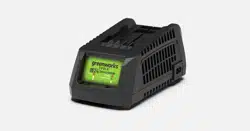Loading ...
Loading ...
Loading ...

4
English (Original Instructions)
EN
DE ES IT FR PT NL RU FI SV NO DA PL CS SK SL HR HU RO BG EL AR TR HE LT LV ET
CHARGING PROCEDURE
NOTE: The battery is not shipped fully
charged. It is recommended to fully charge
before use to ensure that maximum run time
can be achieved. This lithium-ion battery will
not develop a memory and may be charged
at any time.
1. Plug the charger into an AC power outlet.
2. Insert the battery pack (1) into the charger
(2).
12
3
This is a diagnostic charger. The Charger
LED Light (3) will illuminate in specic order
to communicate the current battery status.
They are as follows:
CHARGING PROCEDURE (LED INDICATOR)
BATTERY IS CHARGING:
FULLY CHARGED:
BATTERY IS TOO WARM:
(REMOVE FOR APPROX. 30
MINUTES TO ALLOW TO COOL)
DEFECTIVE BATTERY:
(REMOVE AND REPLACE WITH
NEW BATTERY IF THIS OCCURS)
NO BATTERY PRESENT
GREEN
ORANGE
OFF
RED
RED RED
RED
RED
RED
RED
BLINKING
False Defect Note:
When the battery is inserted into the charger,
and the status LED ashes, remove the
battery from the charger for 1 minute, then
reinsert. If the status LED indicates normal
than the battery pack is good. If the status
LED is still blinking, remove the battery pack
and unplug the charger. Wait 1 minute and
plug the charger back in and reinsert the
battery pack. If the status LED indicates
normal than the battery pack is good. If the
status LED is still blinking then the battery
pack is defective and needs to be replaced.
ENVIRONMENTALLY SAFE BATTERY
DISPOSAL
The following toxic and corrosive materials
are in the batteries used in this tool battery
pack:
Li-ion, a toxic material.
WARNING
All toxic materials must be disposed of in a
specied manner to prevent contamination
of the environment. Before disposing of
damaged or worn out Lithium-ion battery
packs, contact your local waste disposal
agency, or the local Environmental
Protection Agency for information and
specic instructions. Take the batteries to
a local recycling and/or disposal centre,
certied for Li-ion disposal.
WARNING
If the battery pack cracks or breaks, with
or without leaks, do not recharge it and do
not use. Dispose of it and replace with a
new battery pack. DO NOT ATTEMPT TO
REPAIR IT!
To avoid injury and risk of re, explosion,
or electric shock, and to avoid damage to
the environment:
▪ Cover the battery's terminals with heavy-
duty adhesive tape.
▪ DO NOT attempt to remove or destroy
any of the battery pack components.
▪ DO NOT attempt to open the battery
pack.
WARNING
▪ If a leak develops, the released
electrolytes are corrosive and toxic. DO
NOT get the solution in the eyes or on
skin, and do not swallow it.
▪ DO NOT place these batteries in your
regular household trash.
▪ DO NOT incinerate.
▪ DO NOT place them where they will
become part of any waste landfill or
municipal solid waste stream.
▪ Take them to a certified recycling or
disposal centre.
Loading ...
Loading ...
Loading ...
